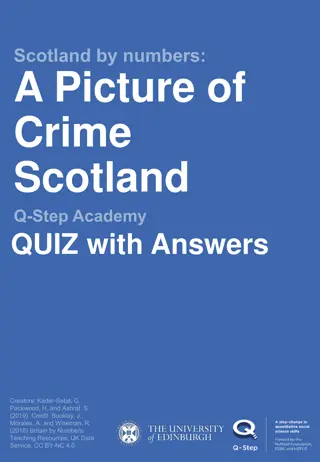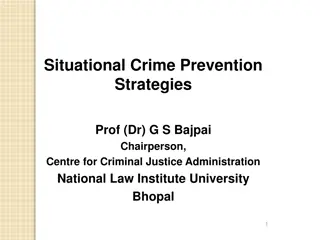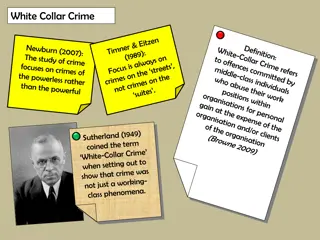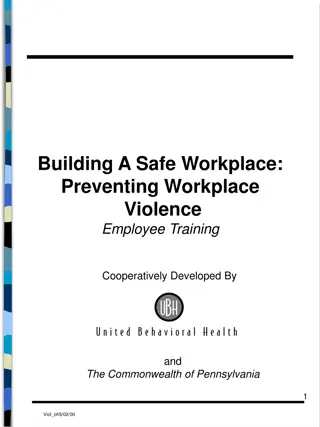Litigating Crime-of-Violence Issues: Johnson, Beckles, and Beyond
Delve into the intricate legal landscape surrounding crime-of-violence issues, focusing on landmark cases like Johnson and Beckles. Explore the implications for Armed Career Criminal Act and U.S. Sentencing Guidelines, while dissecting the residual clause analysis pre- and post-Johnson. Understand how the void for vagueness reasoning reshapes legal precedent and discover what remains of the ACCA post-Johnson.
Download Presentation

Please find below an Image/Link to download the presentation.
The content on the website is provided AS IS for your information and personal use only. It may not be sold, licensed, or shared on other websites without obtaining consent from the author. Download presentation by click this link. If you encounter any issues during the download, it is possible that the publisher has removed the file from their server.
E N D
Presentation Transcript
Litigating Crime-of-Violence Issues: Johnson, Beckles, and Where We Go From Here May 31, 2017 New Orleans, Louisiana
Overview I. Pre-Johnson world II. Summary of Johnson III. Implications: A. Armed Career Criminal Act B. Career Offender C. U.S.S.G. 2K2.1, 7B1.1 D. 18 U.S.C. 16 E. 18 U.S.C. 924(c)
Pre-Johnson Residual Clause Analysis Inquiry under James, Begay, Chambers, Sykes: categorical approach + ordinary case Do elements of offense in ordinary case: a. present risk of injury at similar level to enumerated offenses (generic burglary, arson, extortion, use of explosives)+ b. require purposeful, violent, and aggressive conduct?
Johnson: Residual Clause Void for Vagueness Reasons turn on uncertainty of ordinary case inquiry: 1. Grave uncertainty about how to estimate risk because no one knows how to determine what the ordinary case of a crime is: Gut instinct, common sense, statistics, google search not sufficient guides. 2. Grave uncertainty about how to determine quantum of risk (i.e., how much risk) because quantum of risk is tied to ordinary case. Again, back to ordinary case problem. Denies fair notice and invites arbitrary enforcement
Johnson: Expressly overrules precedent James (2007): Florida attempted burglary qualifies as a violent felony under the residual clause. Sykes (2011): Indiana offense of vehicular flight from an officer qualifies as a violent felony under the residual clause.
Whats left of the ACCA? ACCA violent felony = 1. Force Clause: Has an element the use, attempted use, or threatened use of physical force against a person, or 2. Enumerated offenses: burglary, arson, extortion, use of explosives (determined by generic definition). Categorical approach applies: If most innocent conduct or full range of conduct covered by the elements of the statute does not match these definitions, prior cannot qualify as violent felony. United States v. Torres-Miguel, 701 F.3d 165 (4thCir. 2012).
ACCA Force Clause: Be Careful Almost Nothing Counts As Violent Felony
Fighting Against the Force Clause Four Key Issues to look for: Requires violent force, not unwanted touching Force must be directed against a person, not property Requires the use of force, not merely the causation of physical injury. Force must be used intentionally, not recklessly or negligently Practice Point: Many of the best force-clause cases have been litigated under U.S.S.G. 2L1.2.
Issue 1: Violent Force Requirement Violent Force means strong physical force that is capable of causing physical injury or pain to another person. Johnson v. United States, 559 U.S. 133 (2010) Examples of unwanted touching or offensive touching : Federal assault under 18 U.S.C. 111(a). United States v. Bell, 158 F. Supp.3d 906 (N.D. Cal. 2016) (collecting federal appellate cases); United States v. Ama,__ Fed. Appx. __, 2017 WL 1325247 (10thCir. 2017) (same). Assault or Battery. United States v. Johnson, 559 U.S. 133 (2010) (Florida); United States v. Holloway, 630 F.3d 252 (1stCir. 2011)(Massachusetts simple assault and battery); United States v. Lattanzio, __F. Supp.3d__, 2017 WL 519241 (D. Mass. 2017) (Massachusetts assault and battery with a dangerous weapon); United States v. Fish, 758 F.3d 1 (1stCir. 2014) (same); United States v. Royal, 731 F.3d 333 (4thCir. 2013) (Maryland second degree assault). Resisting arrest. United States v. Aparico-Soria, 740 F.3d 152 (4thCir. 2014) (en banc) (Maryland); United States v. Flores-Cordero, 723 F.3d 1085 (9th Cir. 2013) (Arizona); United States v. Almenas, 553 F.3d 27 (1st Cir. 2009) (Massachusetts); United States v. Lee, 821 F.3d 1124 (9thCir. 2016) (California) Battery on a law enforcement officer; Battery on pregnant woman. United States v. Carthorne, 726 F.3d 503 )(4th Cir. 2013) (Virginia); United States v. Braun, 801 F.3d 1301 (11thCir. 2015) (Florida).
Issue 1: Violent Force Requirement Don t be deceived by labels: Sometimes offense will have element labeled force or violence, but that does not mean it has element of ACCA violent force. Examples: Federal robbery of government property. United States v. Bell, 158 F. Supp.3d 906 (N.D. Cal. 2016) ( violence can be accomplished by de minimis force). Virginia robbery. United States v. Winston, __ F.3d__, 2017 WL 977031 (4thCir. 2017) ( violence can be accomplished by de minimis force i.e, physical jerking ). Missouri second degree robbery. United States v. Bell, 840 F.3d 963 (8thCir. 2016)( force can be accomplished by any physical contact, even a nudge). North Carolina robbery. United States v. Gardner, 823 F.3d 793 (4thCir. 2016) ( force can be accomplished by de minimis force, i.e., pushing someone to the ground). Massachusetts armed robbery. United States v. Parnell, 818 F.3d 974 (9thCir. 2016) ( force and violence can be accomplished by de minimis force); United States v. Lattanzio, __ F.Supp.3d__, 2017 WL 519241 (D. Mass. 2017). Puerto Rico robbery. United States v. Castro-Vasquez, 802 F.3d 28 (1stCir. 2015) ( violence or intimidation can be accomplished by slightest use of force ).
Issue 1: Violent Force Requirement Don t be deceived by labels: Sometimes offense will have element labeled force or violence, but that does not mean it has element of ACCA violent force. Examples: Arkansas robbery. United States v. Eason, 829 F.3d 963 (8thCir. 2016) (court could not conclude that degree of physical force required under offense requires violent force). Maine robbery. United States v. Mulkern, __ F.3d__, 2017 WL 1363791 (1stCir. 2017) ( any physical force suffices to satisfy physical force element ). Kansas robbery. United States v. Nicholas, __ Fed. Appx.__, 2017 WL 1429788 (10thCir. 2017) ( violence element of robbery includes purse snatching). Wisconsin/Oregon//New York/Nevada/Penn. robberies. United States v. Robinson, Case No. 16-C-156 (D. Wisc. May 24, 2016); United States v. Dunlap, 162 F. Supp.3d 1106 (D. Ore. 2016); United States v. Batista, 2017 WL 2105692 (W. D. Va. May 11, 2017); United States v. Johnson, __ F. Supp.3d __, 2016 WL 6684211 (E.D.N.Y. Nov. 12, 2016); United States v. Avery, 2017 WL 29667 (D. Nev. Jan. 3, 2017); Thrower v. United States, __ F. Supp.3d__, 2017 WL 1102871 (E.D.N.Y. 2017); United States v. Singleton, 2017 WL 1508955 (E. D. Pa. April 26, 2017). Maryland robbery. United States v. Martin, Case No. 14-4779 (4thCir. Sept. 16, 2016) (upon gov t. s concession, court found it is not a violent felony but no reasoning given); United States v. Wilson, __ F. Supp.3d__, 2017 WL 1383644 (D.D.C. 2017). D.C. robbery. In re Sealed Case, 548 F.3d 1085 (D.C. 2008) ( force or violence defined by statute to include purse-snatching offenses: sudden or stealthy seizure or snatching ). Note: same argument excludes similar offenses, such as larceny from the person or pickpocketing
Issue 1: Violent Force Requirement Kidnapping / False Imprisonment/Hostage Taking: physical restraint, detention, holding, mental restraint does not automatically equal physical force. Delgado-Hernandez v. Holder, 697 F.3d 1125 (9th 2012) (California kidnapping does not satisfy force clause because restraint can be accomplished through any means of instilling fear even through deception). United States v. Moreno-Florean, 542 F.3d 445, 450-52 (5th Cir. 2008) (determining that California kidnapping statute did not include physical force as an element because the crime could be accomplished through non-physical means). United States v. Gonzalez-Perez, 472 F.3d 1158 (11th Cir. 2012) (Florida false imprisonment does not satisfy force clause because restraint can be accomplished secretly ). United States v. Sherbondy, 865 F.2d 996 (9th Cir. 1988) (Model Penal Code definition of kidnapping does not require force because it covers kidnapping by trickery or deceit). United States v. Marquez-Lobos, 697 F.3d 759 (9thCir. 2012) (Arizona kidnapping , which includes abduction of minor, requires lack of consent by lawful abduction but no use or threat of force). United States v. Phelps, 17 F.3d 1334 (10thCir. 1994) (Missouri kidnapping does not require force or threat of force). United States v. Cervantes-Blanco, 594 F.3d 576 (5thCir. 2007) (Colorado kidnapping does not require force or threat of force because can be accomplished by deceit). United States v. Williams, 110 F.3d 50 (9thCir. 1997) (Oregon kidnapping does not require force or threat of force because it can be committed by deception). United States v. Najera-Mendoza, 683 F.3d 627 (5thCir. 2012) (Oklahoma kidnapping can be committed by de minimis force; therefore, not crime of violence under force clause). United States v. Martinez-Romero, 817 F.3d 917 (5thCir. 2016) (Florida kidnapping does not require force or threat of force).
Issue 1: Violent Force Requirement Kidnapping/False Imprisonment/Hostage Taking: physical restraint, detention, holding does not automatically equal physical force. Federal kidnapping: United States v. Jenkins, 849 F.3d 390 (7thCir. 2017) (federal kidnapping does not have a force requirement because it can be accomplished by deception). United States v. Bustos, 2016 WL 6821853 (E.D. Cal. Nov. 17, 2016) (federal kidnapping does not have element of violent force because it can be accomplished by trickery or deceit); United States v. Rubio, 2016 WL 6821854 (E. D. Cal. Nov. 17, 2016) (same). United States v. Hughes, 716 F.2d 234, 239 (4th Cir. 1983) (noting that a kidnapper may use[] deceit and trickery to accomplish his purpose rather than overt force ); see also United States v. Wills, 234 F.3d 174, 177 (4th Cir. 2000) ( By its terms, 1201(a) criminalizes kidnappings accomplished through physical, forcible means and also by nonphysical, nonforcible means. ); see Torres v. Lynch, 136 S. Ct. 1619 (2016) (suggesting that kidnapping is not cv). Federal hostage taking: United States v. Carrion-Caliz, 944 F.2d 220 (5thCir. 1991); United States v. Si Lu Tian, 339 F.3d 143 (2d Cir. 2003) (hostage taking can be accomplished by deception). Hernandez v. United States, 2016 WL 8078311 (S. D. Fla. 2016) (federal hostage taking requires no use or threatened use of force);Juan Becerra-Perez v. United States, CR 04-0235 (C.D. Cal. Feb. 15, 2017) (same).
Issue 1: Violent Force Requirement Sex offenses based on absence of legally valid consent do not qualify under the force clause. Statutory Rape United States v. Rangel-Castaneda, 709 F.3d 373 (4th Cir. 2013) (Tennessee aggravated statutory rape); United States v. Daye, 571 F.3d 225 (2d Cir. 2009) (Vermont statutory rape); United States v. Madrid, 805 F.3d 1204 (10thCir. 2015) (Texas aggravated sexual assault of a child). Involuntary or Incompetent Consent United States v. Shell, 789 F.3d 335 (4th Cir. 2015) (North Carolina second-degree rape of victim who is mentally disabled, mentally incapacitated, or physically helpless ). If force is an element, look for state case law extending the provision to constructive force (i.e., mental compulsion not physical force) situations.
Issue 1: Violent Force Requirement Offenses with a weapon element do not qualify if no active use required of weapon: United States v. Parnell, 818 F.3d 974 (9thCir. 2016) (armed robbery not a crime of violence because weapon need not be fired, employed to effectuate robbery, used in a threatening manner, or even generally or openly displayed ). United States v. Werle, 815 F.3d 614 (9thCir. 2016) (Washington riot statute not a crime of violence because weapon need not be used but just readily available ).
Issue 2: Property vs. Person Force, even violent, against property does not qualify under ACCA force clause. Examples: Hobbs Act robbery/ federal bank robbery includes threatening to injure one s property. That should disqualify Hobbs Act robbery/bank robbery from qualifying under the force clause: United States v. Giddins, Case No. 15-4039 (issue pending in the 4thCir. as to whether federal bank robbery qualifies as crime of violence under force clause because it can be violated by extortionate means including threat of economic harm); United States v. Hunt, Case No. 16-4521 (issue pending in 4thCir. as to whether federal Hobbs Act robbery qualifies as a crime of violence for same reasons). Washington state first and second degree robbery includes threatening injury to property; therefore, cannot qualify. United States v. Navarro, 2016 WL 1253830 (E.D. Wash. March 10, 2016); United States v. Bercier, 192 F. Supp.3d 1142 (E. D. Wash. 2016); Lilley v. United States, 2016 WL 6997037 (W. D. Wash. Nov. 30, 2016). Maryland robbery includes threatening injury to property; therefore, cannot qualify. Douglas v. State, 9 Md. App. 647 (Md. Ct. Spec. App. 1970); Giles v. State, 8 Md. App. 721 (Md. Ct. Spec. App. 1970); United States v. Martin, Case No. 14-4779 (4thCir. Sept. 16, 2016). Ohio robbery includes threat against things - not persons; therefore, cannot qualify. United States v. Litzy, 137 F. Supp.3d 920 (S.D.W.V. 2015). Ohio robbery with a dangerous weapon also includes threatening injury to things. United States v. Patterson, 2015 WL 5675110 (N.D. Ohio Sept. 25, 2015); United States v. Nagy, 144 F. Supp.3d 928 (N.D. Ohio 2015). North Carolina conviction for discharging firearm into occupied building does not qualify because it is force against property not a person. United States v. Parral-Dominguez, 794 F.3d 440 (4thCir. 2015).
Issue 3: Using Force vs. Causing Injury Offenses with elements requiring physical injury, serious physical injury, or even death do not equal violent force. This is true because physical injury can be committed without use of strong physical force: - - - - - - - poisoning, laying a trap, exposing someone to hazardous chemicals, withholding medicine, locking someone in car on a hot day, starving someone to death, neglecting a child, etc., placing a barrier in front of a car, which causes an accident, leaving an unconscious person in middle of road -
Issue 3: Using Force vs. Causing Injury Examples: Offenses with physical injury, serious physical injury, or even death elements that do not qualify as violent felonies under the force clause: Assault Offenses Connecticut assault requiring intentionally causing physical injury. Whyte v. Lynch, 807 F.3d 463 (1stCir. 2015) (post-Johnson); Chrzanoski v. Ashcroft, 327 F.3d 188 (2d Cir. 2003). Puerto Rico aggravated battery requiring intentional infliction of physical injury. Matter of Guzman- Polanco, 26 I & N Dec. 713 (BIA 2016) (post-Johnson). Texas aggravated assault requiring intentionally causing physical injury. United States v. Zuniga-Soto, 527 F.3d 1110, 1125 n.3 (10th Cir. 2008); United States v. Villegas-Hernandez, 468 F.3d 874, 879 (5th Cir. 2006). Colorado assault requiring defendant to cause bodily injury using a deadly weapon. United States v. Perez-Vargas, 414 F.3d 1282 (10th Cir. 2005); Colorado assault by drugging. United States v. Rodriguez- Enriquez, 518 F.3d 1191 (10th Cir. 2008). New Jersey aggravated assault requiring a defendant to cause significant bodily injury. United States v. Martinez-Flores, 720 F.3d 293, 299 (5th Cir. 2013). Arizona aggravated assault requiring attempt to cause injury with use of dangerous weapon. United States v. Gomez-Hernandez, 680 F.3d 1171 (9thCir. 2012). Arizona endangerment requiring action that creates risk of imminent death or physical injury. United States v. Hernandez-Castellanos, 287 F.3d 876, 881 (9thCir. 2002). North Carolina assault with dangerous weapon with intent to kill. United States v. Brown, __ F. Supp.3d __, 2017 WL 1383640 )(D. D. C. 2017)( post-Johnson). Pennsylvania aggravated assault. United States v. Fisher, 2017 WL 1426049 (E. D. Pa. 2017) (post- Johnson).
Issue 3: Using Force vs. Causing Injury Examples: Offenses with physical injury, serious physical injury, or even death elements that do not qualify as violent felonies under the force clause: Threat Offenses United States v. Torres-Miguel,701 F.3d 165 (4thCir. 2012) (Cal. terroristic threats: threatening an act that results in serious bodily injury or death); United States v. Rico-Mejia, 2017 WL 568331 (5thCir. Feb. 10, 2017) (Arkansas terroristic threats: threatening an act that results in serious physical injury or death) (post-Johnson). Child Abuse Offenses United States v. Gomez, 690 F.3d 194 (4thCir. 2012) (child abuse resulting in physical injury); United States v. Andino-Ortega, 608 F.3d 305 (5thCir. 2010) (causing physical injury to a child); United States v. Lopez-Patino, 391 F.3d 1034, 1037 (9thCir. 2004) (causing child physical injury does not require use of force). Manslaughter Offenses United States v. Garcia-Perez, 779 F.3d 278 (5thCir. 2015) (Florida manslaughter).
Issue 3: Using Force vs. Causing Injury Examples continued: Common offenses with physical injury, serious physical injury, or even death elements that do not qualify as violent felonies under the force clause: Murder See United States v. Hernandez, 831 F.3d 284 (5thCir. 2016) (Florida second degree attempted murder); United States v. Watts, 2017 WL 411341 (D. Kan. Jan. 31, 2017) (Missouri second degree felony murder); United States v. Martinez, Case No. 07-cr-00236- REB-1 (D. Co. Feb. 1, 2017) (Nevada second degree murder);United States v. Nicks, Case No. WJM-15-0321 (D. Co. April 4, 2016) (Colorado second degree murder); United States v. McCutcheon, Case No. JFM-15-654 (D. Md. Aug. 24, 2016)(attempted Maryland second degree murder).
Issue 3: Using Force vs. Causing Injury Examples Continued: Common offenses with physical injury, serious physical injury, or even death elements that do not qualify as violent felonies under the force clause: Federal crimes: Hobbs Act robbery, bank robbery, armed bank robbery, VICAR, carjacking, murder, assault, use of weapon of mass destruction All can be accomplished by putting someone in fear of physical injury or actually causing physical injury or death, but violent force not required. But see United States v. McNeal, 818 F.3d 141 (4thCir. 2016) (finding that federal bank robbery satisfies force clause because it will be rare case that offense is accomplished by non-violent force such as poisoning); United States v. Evans, 848 F.3d 242 (4thCir. 2016) (finding same for federal carjacking).
Issue 3: Using Force vs. Causing Injury Beware: 1) United States v. Castleman, 134 S. Ct. 1405 (2014) (holding that physical injury requires physical force under 18 U.S.C. 922(g)(9) misdemeanor crime of domestic violence definition, but not deciding whether physical injury necessarily requires violent physical force). But see decisions holding Castleman is inapposite United States v. Rico-Mejia, 2017 WL 568331 (5thCir. Feb. 10, 2017) (rejecting government s Castleman theory); Whyte v. Lynch, 807 F.3d 463 (1stCir. 2015) (same); United States v. McNeal, 818 F.3d 141 n.10 (4thCir. 2016) (same); In re Guzman-Polanco, 26 I & N Dec. 713 (BIA 2016) (same); United States v. Fennell, 2016 WL 4702557 (N.D. Tex. Sept. 8, 2016) (same); United States v. Hill, __ F. Supp.3d__, 2016 WL 7076929 (W. D. Penn. 2016) (same); United States v. Villanueva, 191 F. Supp. 3d 178 (D. Conn. 2016) (same); United States v. Watts, 2017 WL 411341 (D. Kan. Jan. 31, 2017) (same); United States v. Fisher, 2017 WL 1426049 (E. D. Pa. 2017) (same); United States v. Brown, 2017 WL 1383640 (D.D.C. 2017) (same); United States v. Rice, 813 F.3d 704 (8thCir. 2016) (see dissent rejecting government s Castleman theory).
Issue 4: Intentional vs. Reckless Conduct All offenses must require intentional use of violent force or intentional threat of violent force; reckless mens rea will not suffice. See Garcia v. Gonzales, 455 F.3d 465 (4thCir. 2006) (assault requiring defendant to recklessly cause serious physical injury using a deadly weapon); United States v. McMurray, 653 F.3d 367, 374-75 (6th Cir. 2011) (aggravated assault requiring defendant to recklessly cause serious bodily injury); Fernandez-Ruiz v. Gonzales, 466 F.3d 1121, 1132 (9thCir. 2006) (en banc) (assault statute requiring reckless physical injury to another); United States v. Vargas-Duran, 356 F.3d 598 (5thCir. 2004) (child endangerment can be satisfied with reckless mens rea); Purohit v. Holder, 441 Fed. Appx. 458 (9thCir. 2011) (voluntary manslaughter has reckless mens rea); United States v. Aitken, 2015 WL 1486925, 2015 WL 1486925 (C. D. Cal. 2015) (same); United States v. Dixon, 805 F.3d 1193 (9th Cir. 2015) (California robbery does not require intentional use of force); United States v. Parnell, 818 F.3d 974 (9thCir. 2016) (Mass. assault and battery with dangerous weapon has reckless mens rea); United States v. Barcenas-Yanez, 826 F.3d 752 (4thCir. 2016) (Texas aggravated assault offense can be violated with reckless mens rea); United States v. Benally, 843 F.3d 350 (9thCir. 2016) (federal involuntary manslaughter has gross negligence mens rea); United States v. Hernandez, 831 F.3d 284 (5thCir. 2016) (Government agrees Florida second degree murder does not have intentional mens rea); United States v. Johnson, __ F. Supp.3d __, 2016 WL 7666523 (N.D. Cal. 2016) (federal arson has reckless mens rea); United States v. Hill, __ F. Supp.3d __, 2016 WL 7076929 (W.D. Pa. 2016) (Pennsylvania simple assault has reckless mens rea); United States v. Watts, 2017 WL 411341 (D. Kan. 2017) (Missouri second degree murder has reckless mens rea); United States v. Sabetta, __ F. Supp.3d__ , 2016 WL 6157454 (D.R.I. 2016) (Rhode Island assault with a dangerous weapon has reckless mens rea); United States v. Wehunt, __ F. Supp.3d__, 2017 WL 347544 (E.D. Tenn. 2017) (Tenn. aggravated assault has a reckless mens rea); United States v. Moore, 203 F. Supp.3d 854 (N.D. Ohio 2016) (Ohio aggravated robbery has reckless mens rea). Argue that even if some general intent exists, a crime satisfies the force clause only if it specifically requires an intent to use or threaten violent force. See Flores-Lopez v. Holder, 685 F.3d 857, 863 (9thCir. 2012); Covarrubias Teposte v. Holder, 632 F.3d 1049 (9thCir. 2011); United States v. Coronado, 603 F.3d 706 (9thCir. 2010) (intentionally discharging a firearm in a negligent manner that creates a risk of injury or death); Brown v. Caraway, 719 F.3d 583 (7thCir. 2013); United States v. Calderon-Pena, 383 F.3d 254 (5thCir. 2004) (intentionally endangering child without intending to cause victim injury).
Issue 4: Intentional vs. Reckless Conduct Threats: Argue intimidation/putting someone in fear of bodily injury does not equal intentional threat if statute does not require defendant to have intent to put another in fear of bodily injury. See United States v. King, 979 F.2d 801, 803 (10thCir. 1992) (threat under force clause means both an intent to use force and a communication of that threat ). Examples of statutes that do not have intentional mens rea: Utah witness tampering can be committed without any intent to threaten force Culp v. United States, 2016 WL 5400395 (D. Utah Sept. 27, 2016). Federal bank robbery can be committed without proof of intent to intimidate: United States v. Doriety, Case No. C16-0924-JCC (W. D. Wash. Nov. 10, 2016)(federal unarmed bank robbery is not crime of violence under force clause because no intent to use force or communication of that threat required note: case dismissed after Beckles, but you can still use reasoning); United States v. Knox, 2017 WL 347469 (W. D. Wash. Jan. 24, 2017) (same ); see also cases demonstrating that federal bank robbery can be violated without intentional threat of force: United States v. Yockel, 320 F.3d 818 (8thCir. 2003); United States v. Kelley, 412 F.3d 1240 (11thCir. 2005); United States v. Woodrup, 86 F.3d 359 (4thCir. 1996). But see United States v. McNeal, 818 F.3d 141 (4thCir. 2016) (finding that federal bank robbery satisfies intentional mens rea); United States v. Armour, 840 F.3d 904 (7thCir. 2016) (same); In re Sams, 830 F.3d 1234 (11thCir. 2016) (same).
Issue 4: Intentional vs. Reckless Conduct Continued examples: Federal first degree murder includes felony murder, which does not require intentional use of violent force. Federal second degree murder can be committed with reckless disregard for human life.
Issue 4: Intentional vs. Reckless Conduct Beware: Voisine v. United States, 136 S. Ct. 2272 (2016) (holding that force clause for purposes of 922(g)(9) misdemeanor crime of domestic violence only requires mens rea of recklessness; but recognizing that force clause under 18 U.S.C. 16 may require intentional mens rea because it has different purpose; so Voisine does nothing to disturb rulings of lower courts requiring intentional mens rea for 16 and other analogous force clauses like ACCA/career offender/924(c)); United States v. Fogg, 836 F.3d 951 (8thCir. 2016) (applying Voisine to ACCA); United States v. Howell, 838 F.3d 489 (5thCir. 2016) (applying Voisine to U.S.S.G. 4B1.2). See United States v. Lattanzio, __ F. Supp. 3d __, 2017 WL 519241 (D. Mass. 2017) (Voisine inapposite to ACCA force clause);; Bennett v. United States, 2016 WL 3676145 (D. Me. 2016) (same); United States v. Johnson, __ F. Supp.3d __, 2016 WL 7666523 (N. D. Cal. 2016) (same); United States v. Sabetta, __F. Supp.3d __ , 2016 WL 6157454 (D. R. I. 2016) (same); United States v. Fennell, 2016 WL 4702557 (N.D. Tex. Sept. 8, 2016) (same); Jefferson v. United States, 2016 WL 6023331(S. D. Ala. Oct. 13, 2016) (same); Jaramillo v. United States, 2016 WL 5947265 (D. Utah Oct. 13, 2016) (same); United States v. Fisher, 2017 WL 1426049 (E. D. Pa. 2017) (same); United States v. Brown, __ F. Supp.3d__, 2017 WL 1383640 (D.D.C. 2017) (same); Broadbent v. United States, 2016 WL 5922302 (D. Utah Oct. 11, 2016) (Voisine inapposite to career offender force clause); United States v. Wehunt, __ F. Supp.3d__, 2017 WL 347544 (E. D. Tenn. 2017) (same); United States v. Hill, __ F. Supp.3d__, 2016 WL 7076929 (W. D. Penn. 2016) (same).
ACCA Enumerated Offenses: Be Careful
ACCA Enumerated Offenses: Must Be Generic Generic Burglary: 3 elements 1. unlawful entry or remaining California first degree burglary, Descamps v. United States, 133 S. Ct. 2276 (2013). Washington residential burglary, United States v. Wilkinson, 589 Fed. Appx. 348 (9thCir. Dec. 11, 2014) (no trespass required). 2. in a building or structure (not in a vehicle, boat, motor home, or telephone booth) Maryland first degree burglary, United States v. Henriquez, 757 F.3d 144 (4thCir. 2014); Oregon first & second degree burglary, United States v. Mayer, 560 F.3d 948 (9thCir. 2009); United States v. Grisel, 488 F.3d 844 (9thCir. 2007) (en banc); United States v. Cisneros, 826 F.3d 1190 (9thCir. 2016); West Virginia burglary, United States v. White, 836 F.3d 437 (4thCir. 2016) (4thCir. 2016). 3. with intent to commit a crime Maryland fourth degree burglary, United States v. Martin, 753 F.3d 485 (4thCir. 2014); Minnesota burglary, United States v. McCarthur, __F.3d__, 2017 WL 744032 (8thCir. 2017). Generic Arson Delaware third degree arson not generic arson, Brown v. Caraway, 719 F.3d 583 (7thCir. 2013) (lacks the generic requirement of malicious or willful mens rea). ****Generic arson definition not clear Torres v. Lynch, 136 S. Ct. 1619 (2016). Generic Extortion North Carolina robbery not generic extortion; robbery has an element requiring lack of consent, but extortion requires consent. United States v. Gardner, 823 F.3d 793 (4thCir. 2016); United States v. Dixon, 805 F.3d 1193 (9thCir. 2015) (California robbery not extortion for same reason). See also Ocasio v. United States, 136 S. Ct. 1423 (2016) (Hobbs Act extortion is not same as Hobbs Act robbery because robbery requires lack of consent, but extortion requires consent).
Final ACCA Issue Conspiracies, Attempts, and Aiding and Abetting Be Careful
Conspiracies Conspiracies never qualify as violent felonies under the force clause or the enumerated offenses clause, no matter what the object is of the conspiracy. 1. Enumerated Offenses Clause: Does not include inchoate offenses. See United States v. James, 550 U.S. 192 (2007) 2. Force Clause: Unlawful agreement + sometimes overt act does not = force or attempted force. Pre-Johnson cases: United States v. White, 571 F.3d 365 (4thCir. 2009); United States v. Gore, 636 F.3d 728 (5thCir. 2011); United States v. Fell, 511 F.3d 1035 (10thCir. 2007); United States v. King, 979 F.2d 801 (10thCir. 1992). Post-Johnson cases: United States v. Gonzalez-Ruiz, 794 F.3d 832 (7thCir. 2015) (finding conspiracy to commit armed robbery not violent felony); United States v. Melvin, No. 13-4857 (4thCir. Oct. 20, 2015) (finding conspiracy to commit robbery with a dangerous weapon not a violent felony). United States v. Smith and Merritte, 2016 WL 2901661 (D. Nev. 2016) (conspiracy to commit Hobbs Act robbery not crime of violence under force clause); United States v. Luong, 2016 WL 1588495 (E.D. Cal. 2016) (same); United States v. Edmundson, 153 F. Supp.3d 857 (D. Md. 2015) (same); United States v. Baires-Reyes, 191 F. Supp.3d 1046 (N. D. Cal. 2016) (same); Duhart v. United States, 2016 WL 4720424 (S. D. Fla. Sept. 9, 2016) (same); United States v. Benitez, Case No. 13-cr-20606-UU (S.D. Fla. April 6, 2017);Alvarado v. United States, 2016 WL 6302517 (Cent. D. Cal. Oct. 14, 2016) (RICO conspiracy not crime of violence under force clause); United States v. Shumilo, 2016 WL 6302524 (Cent. Dist. Cal. Oct. 24, 2016) (same).
Attempts Do not qualify as enumerated offenses. United States v. James, 550 U.S. 192 (2007) (attempted burglary is not burglary). Qualify under force clause if (1) the object of the attempt satisfies the force clause and (2) the attempt statute must be generic attempt, which requires a) a substantial step and b) probable desistance. United States v. James, 550 U.S. 192 (2007); United States v. Gonzalez-Monterroso, 745 F.3d 1237 (9thCir. 2014) (real substantial step required); United States v. Garcia-Jimenez, 807 F.3d 1079 (9th Cir. 2015) (generic attempt requires probable desistance defendant s actions indicate that crime will take place unless interrupted by independent circumstances). See Montoya v. United States, 2016 WL 6810727 (D. Utah Nov. 17, 2016) (Utah attempted murder only requires prepatory steps; thus, not generic attempt qualifying under force clause).
Aiding and Abetting May qualify if it is 1) generic aiding and abetting and 2) underlying offense satisfies the force clause or is a generic enumerated offense. Requires proof that the defendant 1) took an affirmative act in furtherance of the underlying offense 2) with the intent of facilitating the commission of the offense. See Rosemond v. United States, 134 S. Ct. 1240, 1245 (2014). The intent requirement is satisfied only when the government proves the person actively participate[d] in a criminal venture with full knowledge of the circumstances constituting the charged offense. Id. at 1248 49. The required knowledge must be advance knowledge, which means knowledge at a time the accomplice can do something with it most notably, opt to walk away. Id. at 1249 50.
CAREER OFFENDER (OLD AND NEW)
Old Career Offender Provision before August 1, 2016: (U.S.S.G. 4B1.2) Crime of violence => Three-Part Definition Force Clause: offense has as an element the use, attempted use, or threatened use of physical force against the person of another. Enumerated offenses: burglary of a dwelling, arson, extortion, use of explosives. Residual Clause: offense that otherwise involves conduct that presents a serious potential risk of physical injury to another. Commentary: murder, manslaughter, kidnapping, aggravated assault, forcible sex offenses, robbery, arson, extortion, extortionate extension of credit, and burglary of a dwelling, unlawful possession of saw-off shotgun. Also includes conspiracy, attempt, and aiding and abetting. Remember: Categorical approach applies
Beckles v. United States, 137 S. Ct. 886 (Mar. 6, 2017) Holding: Johnson does not render the residual clause under the advisory guideline unconstitutionally void because the void for vagueness doctrine does not apply to advisory guidelines: advisory guidelines do not fix the permissible range of sentence, but merely guide the exercise of a court s discretion in choosing an appropriate sentence. Note: Beckles did nothing at all to undo Johnson s holding that the residual clause is a black hole and hopelessly indeterminate.
Post-Beckles direct review career offender cases based on old guideline 1. Argue that under Begay, the crime does not qualify as a crime of violence under the residual clause due. 2. Alternatively, argue that a crime of violence finding based on residual clause would be procedurally unreasonable because: - it is impossible to interpret the hopelessly indeterminate residual clause as Johnson says. - in turn, it is impossible for the court to correctly calculate the guideline range based on the residual clause. - thus, sentence is procedurally unreasonable under Gall v. United States, 552 U.S. 38, 49 (2007). See United States v. Lee, 821 F.3d 1124, 1136 (9thCir. 2016) (Ikuta, C.J., dissenting); In re Hunt, 835 F.3d 1277, 1283 (11thCir. 2016) (Rosenbaum, D.J., concurring, joined by Wilson and J. Pryor, C.J.J.)
Post-Beckles direct review career offender cases based on old guideline: continued 3. If commentary offense is in issue, argue that sentence is still procedurally unreasonable because: a) your client s relevant prior does not satisfy generic definition of commentary enumerated offense and b) Commission was no more capable of deciphering the inscrutable residual clause than the Supreme Court and the lower courts. Thus, reliance on the commentary to calculate the guideline range is just as procedurally unreasonable as reliance on the residual clause itself. 4. Alternatively, argue that a sentence based on the residual clause is substantively unreasonable because it results in an arbitrary increase in sentence and unwarranted sentencing disparity. Note that scores of prisoners already got relief pre-Beckles and your client should too. In fact, assistant solicitor general at oral argument said that those who already got relief will keep their sentences.
New Career Offender Provision (Effective August 1, 2016) 1. Force Clause: Has an element the use, attempted use, or threatened use of physical force against a person, or 2. Enumerated offenses: murder, voluntary (not involuntary) manslaughter, kidnapping, aggravated assault, burglary of a dwelling, forcible sex offense, robbery, arson, extortion, or use or unlawful possession of a firearm described in 26 U.S.C. 5845(a) (sawed off shotgun, silencer bomb, machine gun), or explosive material as defined in 18 U.S.C. 841(c). Forcible sex offense for minors and extortion defined in commentary, but all other enumerated offenses determined by generic definition. Note: This definition is incorporated into 2K2.1 and 7B1.1, so the same arguments apply there.
New Career Offender Provision 2. Enumerated offenses continued: Extortion narrowed definition of generic extortion to obtaining something of value from another by wrongful use of (A) force, (B) fear of physical injury, or (C) threat of physical injury. Threat against property or reputation no longer enough. Forcible sex offense includes sex offenses where consent is involuntary, incompetent, or coerced. But sexual abuse of a minor and statutory rape count only if they satisfy elements of 18 U.S.C. 2441(c). In other words, these offenses must have following elements: Either minor victim must be between ages 12-15 and 4 years younger than defendant + defendant engaged in sexual act using force, threats of force, rendered minor unconscious, or drugged minor, etc., or Sexual act with minor under the age of 12. Remember: categorical approach applies under old law and new law.
New Career Offender Commentary The new commentary only includes inchoate offenses: conspiracy, attempts, and aiding and abetting Two challenges: 1. The commentary cannot expand the text of the guideline (force clause or enumerated offenses clause) because it is does not have freestanding power. United States v. Stinson, 508 U.S. 36 (1993); United States v. Shell, 789 F.3d 335, 340 (4thCir. 2015); United States v. Bell, 840 F.3d 963 (8thCir. 2016); United States v. Rollins, 836 F.3d 737 (7thCir. 2016); United States v. Soto-Rivera, 811 F.3d 53 (1stCir. 2016); United States v. Armijo, 651 F.3d 1226 (10thCir. 2011). Enumerated offenses: Under Stinson, no inchoate offenses can qualify as enumerated offenses because text of career offender guideline only includes completed enumerated offenses. Force clause: Also, conspiracies noted in commentary can t qualify under force clause because not included in text of force clause. 2. The prior conspiracy, attempt, or aiding and abetting offense is not generic. See previous slide on generic definition of attempt and aiding and abetting. See also United States v. Martinez-Cruz, 836 F.3d 1305, 1314 (10thCir. 2016) (generic conspiracy requires an agreement to commit a crime plus an overt act in furtherance of the agreement); United States v. Garcia-Santana, 774 F.3d 528, 535-40 (9thCir. 2014) (same). Also, argue that generic conspiracy requires bilateral agreement to commit crime not enough that one of the conspirators was undercover cop.
Career Offender: Challenges to Instant Offense Be Careful: Make challenge to instant federal offense as well as priors. If instant offense does not qualify as crime of violence, then can t be career offender no matter what the priors are.
18 U.S.C. 16 Crime of violence definition (Used for determining old 8-level aggravated felony bump in U.S.S.G. 2L1.2(b)(1)(C) and many other federal provisions like VICAR, Three-Strikes, Bail Reform Act). 1. 18 U.S.C. 16(a) Force Clause 2. 18 U.S.C. 16(b) Residual Clause Note: No Enumerated Offenses Clause
18 U.S.C. 16(b) Crime of violence definition under residual clause Residual Clause: Offense qualifies as crime of violence if by its nature, [it] involves a substantial risk that physical force against the person or property of another may be used in the course of committing the offense. Shuti v. Lynch, 828 F.3d 440 (6thCir. 2016); Dimaya v. Lynch, 803 F.3d 1110 (9thCir. 2015), United States v. Vivas-Ceja, 808 F.3d 719 (7th Cir. 2015), Golicov v. Lynch, 837 F.3d 1065(10thCir. 2016), Baptise v. Attorney General, 841 F.3d 601 (3d Cir. 2016) hold 16(b) void for vagueness because: 1) same categorical ordinary case inquiry applies here that was struck down in Johnson. See United States v. Avila, 770 F.3d 2014 (4thCir. 2014); United States v. Keelan, 786 F.3d 865 (11thCir. 2015); Rodriguez-Castellon v. Holder, 733 F.3d 847 (9thCir. 2013). 2) same uncertainty about how to determine quantum of risk substantial risk of force tied to ordinary case. Note: The type of risk substantial risk in 16(b) vs. serious potential risk in ACCA completely irrelevant because Johnson turned on ordinary case approach not type of risk. See United States v. Welch, 136 S. Ct. 1257, 1262 (2016).
18 U.S.C. 16(b) Crime of violence definition under residual clause Beware: United States v. Gonzalez-Longoria, 831 F.3d 670 (5thCir. 2016) (en banc) (16(b) not void for vagueness). But the Supreme Court granted cert in Lynch v. Dimaya to resolve split.
Whats left of 18 U.S.C. 16 ? 16(a) crime of violence force clause same as career offender/ACCA but has element of physical force against property of another: Force Clause: Has an element the use, attempted use, or threatened use of physical force against a person, or property of another. But still must be violent force against property, not just injury to property so, for example, Hobbs Act robbery and bank robbery, which can be violated by injury to property even intangible property do not qualify. And must be force against property of another Lookout for arson statutes that do not require as such (for example, federal arson). Categorical approach: If most innocent conduct or full range of conduct covered by the statute does not match this definition, prior cannot qualify as crime of violence. United States v. Torres-Miguel, 701 F.3d 165 (4thCir. 2012).
Elements of 18 U.S.C. 924(c) Section 924(c) provides in pertinent part: [A]ny person who, during and in relation to any crime of violence or drug trafficking crime . . . for which the person may be prosecuted in a court of the United States, uses or carries a firearm, or who, in furtherance of any such crime, possesses a firearm, shall, in addition to the punishment provided for such crime of violence or drug trafficking crime - [be sentenced to a certain number of years depending on the facts of the crime] . . . .
18 U.S.C. 924(c)(3) Crime of violence definition: two clauses Identical to 18 U.S.C. 16, but looking at instant offense rather than prior conviction: 1. 18 U.S.C. 924(c)(3)(A) Force Clause 2. 18 U.S.C. 924(c)(3)(B) Residual Clause Note: No Enumerated Offenses
18 U.S.C. 924(c)(3)(B): Crime of violence definition under residual clause Same language as 18 U.S.C. 16(b) Residual Clause: Offense qualifies as crime of violence if by its nature, [it] involves a substantial risk that physical force against the person or property of another may be used in the course of committing the offense. Void for vagueness for same reasons noted under 16(b). Same categorical ordinary case inquiry applies to 924(c)(3)(B). Supreme Court s decision in Dimaya should control here, but government may fight even if we win Dimaya. See United States v. Acosta, 470 F.3d 132, 135 (2d Cir. 2006); United States v. Fuertes, 805 F.3d 485, 497-99 (4th Cir. 2015); United States v. Jennings, 195 F.3d 795, 797-98 (5th Cir. 1999); United States v. Moore, 38 F.3d 977, 979 (8th Cir. 1994), abrogated on other grounds by Leocal v. Ashcroft, 543 U.S. 1 (2004); United States v. Amparo, 68 F.3d 1222, 1225 (9th Cir. 1995); United States v. Serafin, 562 F.3d 1105, 1107-08 (10th Cir. 2009); United States v. McGuire, 706 F.3d 1333, 1336-37 (11th Cir. 2013); United States v. Kennedy, 133 F.3d 53, 56-57 (D.C. Cir. 1998)
18 U.S.C. 924(c)(3)(B) Crime of violence definition under residual clause Courts finding 924(c) residual clause void for vagueness for same reasons 16(b) is void for vagueness: United States v. Cardena, 842 F.3d 959 (7thCir. 2016); United States v. Baires-Reyes, 191 F. Supp.3d 1046 (9thCir. 2016); United States v. Smith and Merritte, 2016 WL 2901661 (D. Nev. 2016); United States v. Luong, 2016 WL 1588495 (E.D. Cal. 2016);United States v. Lattanaphom, 159 F. Supp.3d 1157 (E.D. Cal. 2016); United States v. Bell, 158 F. Supp.3d 906 (N.D. Cal. 2016); United States v. Edmundson, 153 F. Supp.3d 857 (D. Md. 2015); Duhart v. United States, 2016 WL 4720424 (S. D. Fla. Sept. 9, 2016); United States v. Shumilo, 2016 WL 6302524 (Cent. Dist. Cal. Oct. 24, 2016). Beware: United States v. Taylor, 814 F.3d 340 (6thCir. 2016) (holding that 924(c) residual clause is not void for vagueness but holding in conflict with Shuti; nonetheless, Shuti says no conflict because categorical approach does not apply to 924(c)) Cert pending. United States v. Hill, 832 F.3d 135 (2d Cir. 2016)( 924(c) not void for vagueness). United States v. Prickett, 839 F.3d 697 (8thCir. 2016) ( 924(c) not void for vagueness) Cert pending.
Whats left of 18 U.S.C 924(c)(3)? Same as 18 U.S.C. 16(a): Force Clause (18 U.S.C. 924(c)(3)(A)): Has an element the use, attempted use, or threatened use of physical force against a person, or property of another (But still must be violent force against property, not just injury to property). Examples of underlying offenses that should not fall under force clause for reasons previously noted: All conspiracies, Hobbs Act robbery, robbery of government property, kidnapping, hostage taking, bank robbery, armed bank robbery, assault, murder, arson, racketeering, VICAR, escape. Categorical approach: If most innocent conduct or full range of conduct covered by the statute does not match this definition, prior cannot qualify as crime of violence. United States v. Torres-Miguel, 701 F.3d 165 (4thCir. 2012). Note: no enumerated offenses.

























